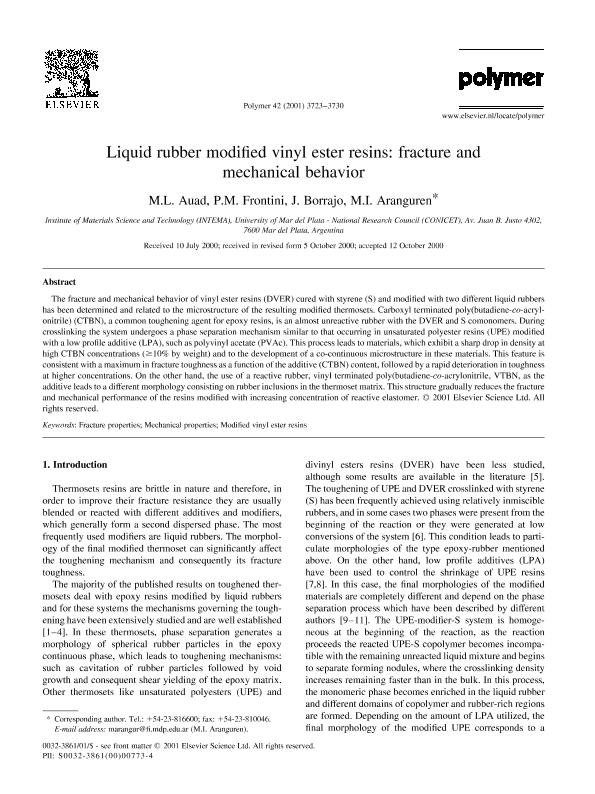Artículo
Liquid rubber modified vinyl ester resins: Fracture and mechanical behavior
Fecha de publicación:
12/01/2001
Editorial:
Elsevier
Revista:
Polymer
ISSN:
0032-3861
Idioma:
Inglés
Tipo de recurso:
Artículo publicado
Clasificación temática:
Resumen
The fracture and mechanical behavior of vinyl ester resins (DVER) cured with styrene (S) and modified with two different liquid rubbers has been determined and related to the microstructure of the resulting modified thermosets. Carboxyl terminated poly(butadiene-co-acrylonitrile) (CTBN), a common toughening agent for epoxy resins, is an almost unreactive rubber with the DVER and S comonomers. During crosslinking the system undergoes a phase separation mechanism similar to that occurring in unsaturated polyester resins (UPE) modified with a low profile additive (LPA), such as polyvinyl acetate (PVAc). This process leads to materials, which exhibit a sharp drop in density at high CTBN concentrations (≥10% by weight) and to the development of a co-continuous microstructure in these materials. This feature is consistent with a maximum in fracture toughness as a function of the additive (CTBN) content, followed by a rapid deterioration in toughness at higher concentrations. On the other hand, the use of a reactive rubber, vinyl terminated poly(butadiene-co-acrylonitrile, VTBN, as the additive leads to a different morphology consisting on rubber inclusions in the thermoset matrix. This structure gradually reduces the fracture and mechanical performance of the resins modified with increasing concentration of reactive elastomer.
Palabras clave:
Fracture Properties
,
Mechanical Properties
,
Modified Vinyl Ester Resins
Archivos asociados
Licencia
Identificadores
Colecciones
Articulos(INTEMA)
Articulos de INST.DE INV.EN CIENCIA Y TECNOL.MATERIALES (I)
Articulos de INST.DE INV.EN CIENCIA Y TECNOL.MATERIALES (I)
Citación
Auad, M. L.; Frontini, Patricia Maria; Borrajo Fernandez, Julio; Aranguren, Mirta Ines; Liquid rubber modified vinyl ester resins: Fracture and mechanical behavior; Elsevier; Polymer; 42; 8; 12-1-2001; 3723-3730
Compartir
Altmétricas




